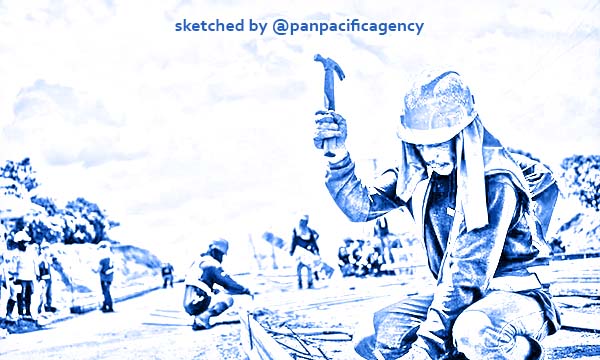Philippines builds infrastructure to spur economy

A Filipino road construction crew on the northern island of Luzon. Photo: Twitter. Sketched by the Pan Pacific Agency.
MANILA, Jan 12, 2020, Asia Times. The Philippines’ economy is leaning heavily on infrastructure projects – along with the traditional growth drivers of consumption and foreign remittances – to deliver an economic boost in 2020. In the meantime, the central bank is keeping monetary conditions easy to help the country catch up with its Southeast Asian neighbors, Asia Times reported.
Manila’s “Build, Build, Build” program has drastically increased infrastructure spending, which is expected to reach 7% of GDP by the end of President Rodrigo Duterte’s term. This compares favorably with only 2% of GDP before he was elected in 2016.
“The government is keen to make up for underspending in 2019,” said a note from HSBC, which blamed the missed target on election disruptions and a delay in passing the budget. The report said construction began in the second half of 2019 on about $25 billion worth of large-scale projects – including the Manila Subway and the PNR North-South Railway. The huge boost should fuel investment growth through 2020.
The government has allocated 24% of its proposed 4.1 trillion peso (US$80 billion) 2020 budget to infrastructure – 12% higher than the previous year.
Highways and bridges are being built throughout Metro Manila, along with a new light rail system in North-East Metro Manila. A shovel-ready subway is being touted as a legacy project that will hopefully alleviate gridlocked streets. In the Visayas and Mindanao, more highways are being expanded to compensate for decades of neglect.
“The government’s clear priority on infrastructure development – which, in our view, boosts long-term growth prospects – is underpinning business confidence,” said Nomura economists in a report.
“In an attempt to fast-track implementation and make the pipeline of projects more realistic, the list of flagship projects has been revised to include those that can be started within the government’s current term (until 2022), even if resulting in a bigger list of 100 projects versus 75 before with a total estimated cost of 4.2 trillion pesos (24% of 2018 GDP).”
The economy is still being propelled by private consumption, given the young demographics, and strong foreign remittances over the past two decades. Services remain buoyant but business process outsourcing, light industry and exports have started to slow, although the decrease can be attributed to external factors.
“Private consumption has been robust and is likely to remain so in 2020. Consumer confidence has turned more upbeat, rebounding to positive territory for the first time in a year as of 3Q19. We expect this to hold up in the year ahead as remittances inflows have been strong in 2019 (unlike in 2018), and we see no big downside risks in the near-term,” HSBC said.
According to Nomura economists, private consumption will likely remain supported by tighter labor markets and higher disposable incomes as a result of last year’s tax reforms, which were based on Duterte’s Tax Reform for Acceleration and Inclusion program (TRAIN).
The IMF has projected the Philippines’ economic growth to rise to 6.3% in 2020 from an estimated 5.7% in 2019, thanks to an increase in government spending and the recent monetary policy easing.
“The medium-term economic outlook remains favorable, especially if the strong structural reform momentum continues,” it said, adding that bold implementation efforts are needed for the strong structural reform momentum to lift medium-term growth and reduce poverty.
Much of the focus under the structural reforms agenda in 2020 will be on the long-delayed tax reforms. The proposed legislation is aimed at gradually lowering corporate income tax rates from 30% to 20% while reducing financial incentives currently granted to corporations. The uncertainty over this proposal contributed to a substantial decline in FDI last year. These uncertainties could hurt sustainable and inclusive growth going forward.
Another risk to growth is the tension between the government and private sector as shown by the government’s run-in with the ABS-CBN television network and disagreements over the water utilities projects.
Duterte threatened violence to investors in Manila’s water utilities projects after a Singapore court ruled against the Philippines government in a dispute between the two. He has also hinted that he would not renew the franchise extension of the ABS-CBN Corp television network. Duterte lashed out at the network after it refused to run his paid advertisement during the 2016 presidential elections.
The bill to extend its license, which expires in March 2020, is currently in the hands of a congress dominated by Duterte’s allies.
Clashes such as these could easily derail important projects and deliver an economic setback. What the nation needs is for the government and the private sector to work together or risk missing economic growth targets.